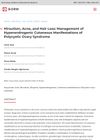TLDR Diagnosing PCOS in teenagers is challenging and should use strict criteria to avoid misdiagnosis and unnecessary worry.
The document from 2010 addresses the difficulties in diagnosing polycystic ovary syndrome (PCOS) in adolescents, noting that the broad criteria used for adults may not be suitable for teenagers due to the transient nature of PCOS features during adolescence. The authors reviewed studies, including one with 73 adolescents, which showed a high prevalence of polycystic ovaries (41%) among those with menstrual irregularities, indicating the need for caution in using ovarian morphology as a sole diagnostic criterion. They recommend using strict criteria, including all elements of the Rotterdam criteria, for diagnosing PCOS in adolescents to prevent misdiagnosis and unnecessary distress. The document suggests that an ovarian volume greater than 10 mL on ultrasound, in conjunction with other criteria, may confirm PCOS in adolescents, but advises against relying solely on ovarian morphology. The authors propose starting treatment for milder forms of PCOS at age 18 and highlight that these forms have lower cardiovascular and metabolic risks. A table with suggested criteria for adolescent PCOS diagnosis is included, aiming to identify those with the classic phenotype while accepting that some cases may be overlooked.
 71 citations
,
November 2009 in “Best Practice & Research in Clinical Obstetrics & Gynaecology”
71 citations
,
November 2009 in “Best Practice & Research in Clinical Obstetrics & Gynaecology” PCOS in teens is hard to diagnose, linked to genetics and lifestyle, and managed with weight loss and medication.
 36 citations
,
November 2009 in “European Radiology”
36 citations
,
November 2009 in “European Radiology” The study found that women with PCOS have more and larger ovarian follicles and differences in ovarian structure, but these features alone can't always diagnose PCOS.
 85 citations
,
June 2008 in “Annals of the New York Academy of Sciences”
85 citations
,
June 2008 in “Annals of the New York Academy of Sciences” PCOS starts in adolescence with hormonal issues, leading to adult health problems, and early treatment is crucial.
 50 citations
,
February 2007 in “Clinical obstetrics and gynecology”
50 citations
,
February 2007 in “Clinical obstetrics and gynecology” Early detection and treatment of PCOS in teenagers is important to manage symptoms and prevent severe issues.
 1744 citations
,
August 2006 in “The Journal of Clinical Endocrinology and Metabolism”
1744 citations
,
August 2006 in “The Journal of Clinical Endocrinology and Metabolism” Polycystic Ovary Syndrome should be seen mainly as a condition of excess male hormones, with a focus on this in its definition.
 4025 citations
,
December 2003 in “Human Reproduction”
4025 citations
,
December 2003 in “Human Reproduction” The 2003 consensus updated PCOS diagnosis criteria and linked PCOS to higher risks of diabetes and heart problems, recommending lifestyle changes to lower these risks.
 September 2016 in “Gynecology Obstetrics and Reproductive Medicine”
September 2016 in “Gynecology Obstetrics and Reproductive Medicine” Effective treatment for skin issues in women with PCOS includes oral contraceptives, antiandrogens, and other medications and procedures.
 1 citations
,
August 2013 in “Springer eBooks”
1 citations
,
August 2013 in “Springer eBooks” Birth control pills and anti-androgen medications help manage hair growth, acne, and hair loss in women with PCOS.
 3 citations
,
January 2012 in “Hanyang Medical Reviews”
3 citations
,
January 2012 in “Hanyang Medical Reviews” The document concludes that more research is needed to create suitable diagnostic criteria and understand PCOS in Korean women, and genetics may allow for personalized treatment.
 10 citations
,
January 2011 in “Skin therapy letter”
10 citations
,
January 2011 in “Skin therapy letter” Women with PCOS often have acne because of high androgen levels, and the article reviewed how to treat this type of acne.










